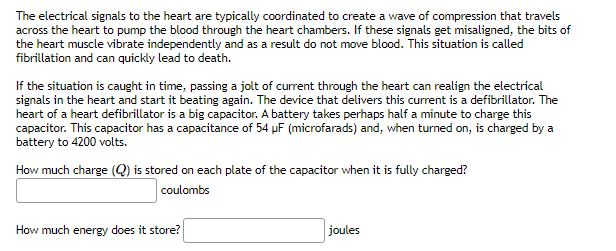Answered step by step
Verified Expert Solution
Question
1 Approved Answer
The electrical signals to the heart are typically coordinated to create a wave of compression that travels across the heart to pump the blood


The electrical signals to the heart are typically coordinated to create a wave of compression that travels across the heart to pump the blood through the heart chambers. If these signals get misaligned, the bits of the heart muscle vibrate independently and as a result do not move blood. This situation is called fibrillation and can quickly lead to death. If the situation is caught in time, passing a jolt of current through the heart can realign the electrical signals in the heart and start it beating again. The device that delivers this current is a defibrillator. The heart of a heart defibrillator is a big capacitor. A battery takes perhaps half a minute to charge this capacitor. This capacitor has a capacitance of 54 F (microfarads) and, when turned on, is charged by a battery to 4200 volts. How much charge (Q) is stored on each plate of the capacitor when it is fully charged? coulombs How much energy does it store? joules The defibrillator delivers that charge through the paddles, and the hope is that the shock resets the heart so it can begin beating normally. The charge is delivered in a sudden pulse that lasts about 100 ms. What is the average current, I, flowing through the body? amperes If all the energy stored in the capacitor is delivered in electric current, what is the voltage difference at which the current was delivered? volts Calculate the effective resistance, R, of the path of the current through the body. ohms
Step by Step Solution
There are 3 Steps involved in it
Step: 1

Get Instant Access to Expert-Tailored Solutions
See step-by-step solutions with expert insights and AI powered tools for academic success
Step: 2

Step: 3

Ace Your Homework with AI
Get the answers you need in no time with our AI-driven, step-by-step assistance
Get Started


